Here is the 2016 runtime shootout results.
Making their debut is the iFlash-Solo and iFlash-Quad, it will be very interesting to see how 4 MicroSD’s compare against the fullsize SD cards used in the iFlash-Solo & iFlash-Dual.
During April 2016, all the SD iFlash adapters were updated to a new platform (internally named iFlash85), with this new platform I have squeezed a little more efficency out of the chipset as well as reducing power and startup times – however, the agressive power saving used in the iPod’s means that the iFlash board sits idle most of the time, so this will not result in much change in the final runtimes compared to the previous platform.
Testing
The test is pretty simple – load up each storage option with the same music, hit play and see how long it takes for the iPod to shutdown. While in actual use the runtimes will be shorter, it still provides a very useful comparison of the different storage mediums.
Test was conducted on the 7.5g iPod Classic, originally came with 160Gb hard drive. I chose this as the original 160Gb hard drive is very efficient as far as spinning platter disks go and the 7.5g itself is the most efficient of this generation of iPods.
Equipment list :-
- 7.5g iPod
- 750mAh Thick Battery (originally 850mAh but it is several years old)
- iFlash-Sata
- iFlash-Solo
- iFlash-Dual
- iFlash-Quad
Storage combinations tested :-
- 160Gb HDD OEM (Toshiba MK1634GAL)
- 256Gb (iFlash-Solo with 256Gb PNY UHS-I U1)
- 768Gb (iFlash-Dual 256Gb PNY UHS-I U3 & 512Gb Kingston UHS-I U1)
- 728Gb (iFlash-Quad 3x 200Gb Sandisk UHS-I & 128Gb Samsung EVO UHS-I)
- 500Gb mSata Samsung 840EVO
- 1Tb mSata Samsung 840EVO
iTunes was used to restore and sync the iPod, the same library was used with all the storage combinations, of course the iPod only sync’d as much as would fit on the storage installed for each test.
Two playlists were created one comprised of 320Kbps MP3 tracks, the other Lossless m4a tracks. I decided to do this as the frequency that the iPod reads from the storage device varies depending on bitrate of the music – e.g. with 320Kbps MP3’s the drive is read every 8 to 12 minutes, where as with a high bitrate lossless m4a the drive is read every 1 to 3 minutes. Very dramatic difference which will have a huge impact on runtime results.
For the iFlash-Dual and iFlash-Quad tests we made sure that the tracks in the playlist were spread across multiple SD card, this was easily done using a disk analyser and manually syncing the library in iTunes.
Benchmarking
I ran some drive benchmarking tests to get a feel for the read and write speeds of each storage medium. As this was a test from computer to iPod, the results would ultimately be limited to the maximum the USB2.0 bus would allow. Interesting none the less.
The mSata and HDD hit the USB2.0 limits with approx. 22Mb/s read and more importantly for syncing 32Mb/s writes to the iPod. The SOLO/DUAL trails here at approx. 23Mb/s writes and 14Mb/s reads – this is expected as the SD platform is spec’d for 25Mb/s transfer rates. The DUAL shows a 1Mb/s improvement on the read speed, this is down to the improved speed of the UHS-I U3 class compared to the U1 class.
MicroSD cards have sadly not reached the same speed as the full size SD cards yet, but the Sandisk 200Gb did perform very well and are the fastest MicroSD cards I have tested so far.
Lets see what this does for actual iPod use by measuring boot time and how long each storage medium takes to fill the read-ahead buffer in the iPod, this will demonstrate the access times and user experience when scrolling and searching through long track lists.
Interestingly, it looks like the storage read speed does not impact the boot time as much as you would expect. Considering the mSata read speeds are much faster than the SDXC. The SDXC only takes 2 seconds longer to boot – The overriding factor is the time the iPod takes to parse through the iTunes database. As a reference, freshly restored iPod boots up in around 24 seconds.
While the SD cards have the slowest raw transfer speeds, they are hands down winners of the Read-ahead and access times test. HDD is the slowest at 7.5 seconds which was to be expected as it takes over 1 second for the drive to spin-up before actually reading any data. The mSata comes in 2nd with a time of 6.7 seconds this maybe surprising but the SATA bus actually takes some time to handshake and negotiate the link from powerup. The SD platform is designed to be ready for access in under 100mS, and the SD cards have virtually instant access times – which result in a blistering 5.7 & 5.6 seconds buffer fill times.
The User Experience reflects the benchmarking results above – the ultimate in smooth scrolling through thousands of albums, near instant album art display goes to the SD cards…..
Runtime Tests
So as mentioned above we have two playlists, one with 320kbps MP3’s (~6Mb per track) and the other with high bitrate lossless m4a files (~30Mb per track).
The iPod was fully charged, reset and booted up, the playlist was selected and played. This was done for the MP3 and Lossless playlist for each storage combination. I setup a low tech IP camera to take a photo of the iPod every minute, which allowed me to time exactly when the iPod switched off (to the nearest minute).
This was always the expected outcome, the mSata drives draw quite large currents during powerup and my iFlash-sata itself has a high performance chipset converting a very high speed SATA bus to the slower iPod PATA bus. The HDD returned a solid performance and sits in the middle ground but having the drawback of its limited capacity.
The most surprising element of these results is in the SD card realm!! The iFlash-Quad wth 4 MicroSD cards effectively has the same runtime as a single full size SD card. The iFlash-Dual also comes in with excellent runtimes – again all of the SD cards based iFlash adapters return amazing runtimes.
iFlash-Dual & iFlash-Quad are able to return good runtimes due to the highly efficient power saving features which keep any cards which are not being used in an idle / sleep mode, so in effect most of the time only one card is active and being accessed.
Power Consumption Tests
To analyse the runtime results further I wanted to look in to actual power consumption of each storage option and how much power the different combination of cards consume.
For this set of tests, I done a full sequential read of the entire storage space while recording the power consumption – the results have been averaged.
Average power consumption figures only tell part of the story, while the two mSata drives have similiar power consumption the graph does not show for example during the power up stage the 1Tb takes much more energy compard to the lower capacity 500Gb model.
I wanted to also see how the various individual SD cards varied in their power consumption, so each card was loaded in to a special rig where I could measure the actual power consumption of the card itself, the same sequential read test was re-run.
WOW! While the Sandisk 200Gb MicroSD only draws ~65mA an amazing power consumption of only 214mW while being read from, the Samsung EVO 128Gb MicroSD on the other hand draws an incredibly high ~110mA a power consumption figure of 363mW. This is even higher than the full size Kingston U1 512Gb which only draws ~95mA a power consumption of only 313mW.
Conclusion
I think all the devices performed well and will provide most users with plenty of musical enjoyment between charges, and how far are you from a USB charge port in your day-to-day life?
I should point out mSata drives have varying levels of power consumption, several mSata drives in the 240Gb – 256Gb range will return runtimes approaching that of the HDD. In the 500Gb range again there is varying power consumption levels to contend with.
The iFlash-Solo, iFlash-Dual and iFlash-Quad returned excellent runtimes, and whichever combination of card capacities you go for, you will get best in class runtimes.
Power consumption figures for the MicroSD cards point to an interesting possiblity that 4 Sandisk 200Gb MicroSD cards, giving you a cool 800Gb iPod, or 2 installed using MicroSD to SD adapters in the iFlash-Dual giving you 400Gb will probably give you several more hours of runtime compared a single fullsize SD of 256Gb or 512Gb!!
Of course you can install MicroSD cards in to either iFlash-Dual or iFlash-Solo using a passive MicroSD to SD adapter, if you want the extra bit of runtime at the cost of slower sync speeds.
With mSata, you do trade runtime for the best price per GB, which maybe the choice you have to make if you need the highest capacity while keeping costs down. However the iFlash-DUAL and iFlash-QUAD do challenge this idea – 2 x 256Gb SDXC or even 4 x 128Gb MicroSD can be bought for less than the price of a single 512Gb mSata.
What about CF Cards…..
Well Compact Flash card and the iFlash alone will give you about 20% increase in runtimes compared to the SDXC. But, the price per Gb for the 128Gb plus capacities are just too expensive. I have been fortunate in testing a few high capacity CF card engineering samples and I found compatiblity with the iPod to be suspect, several had badly implemented LBA48 (i.e. 256Gb CF cards) addressing which caused restore loop issues on the 7.5g iPod.

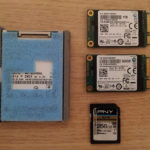
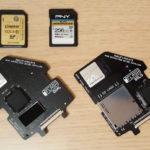
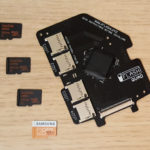
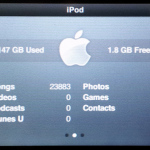
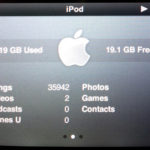
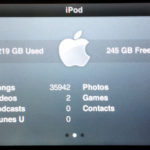
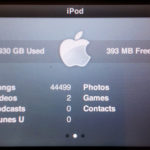
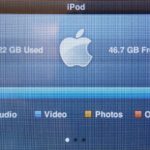
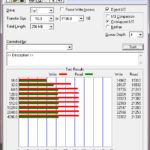
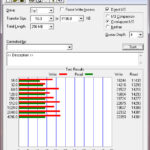
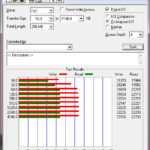
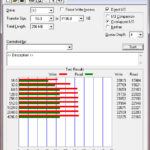
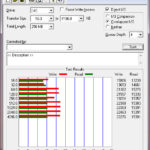
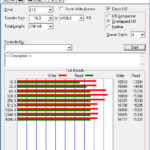
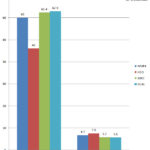
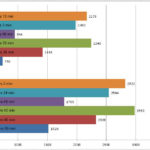
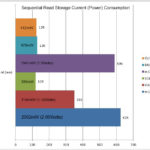
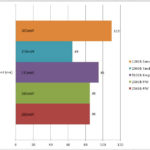
Can I use micro SD Cards on a iFlash Dual SD? planning to put two 256GBs in my iPod 6th Gen. THanks~!
@ZakyJeymz – Yes of course you can use MicroSD in the iFlash-Dual, however the 6th Gen iPods are all limited to 127GB total capacity.
I have a 5th gen and a 7th gen i wish to add iflash and battery upgrade for. I only need upto 512GB.
Whats the best option for me? What uses less battery? And which one gives best performance on playing music on ipod?
From above, it seems that using MicroSD cards (with the iFlash-Quad) will simultaneously give you the most flexibility for purchasing flash memory and one of the best, battery life runtimes. The flexibility is very helpful because you could shop around and choose to buy 4 x 128 GB MicroSD cards, or 2 x 256 GB MicroSD cards, or 2 x 128 GB and 1 x 256 MicroSD cards, or just a single 512 GB MicroSD card, and any of those combinations would achieve your goal of 512 GB… so you can price shop for the best setup (be sure to look at the list of iFlash approved/tested storage though).
However, the regular SD options (iFlash-Solo and iFlash-Dual) do appear to slightly outperform the MicroSD/iFlash-Quad option, albeit with less flexibility in purchasing storage media.
As for performance, I don’t think it will really won’t make much difference in the end. The short, short answer is that the regular HDD will boot the fastest (surprising), but for browsing and playing content, SD cards are the fastest, followed by MicroSD.
So my overall opinion for what you said – if media cost and flexibility is important to you, go with MicroSD/iFlash-Quad. If the media cost/flexibility is not really an issue for you (i.e. you don’t mind buying one large 512 GB SD card that is on the approved list, for example), the iFlash-Solo will perform best for you, by the looks of things.
Anyway – review the shootout above more closely and you can make your own informed decision.
I can tell you as someone who has a 3000mAh battery in my iPod Classic that I can’t even estimate how long it lasts because I charge it once a month now. When I had a 1200mAh one (or something close to that…..), I hit play on the device and let it run straight through my library starting on a Sunday. On Friday, I stopped it because I wanted to use it and it had about 1/3 time left. That’s what…. 5 days at 24 hrs each, so about 120 hrs using 2/3 of the battery making runtime about 180hrs for music (including lossless) with a Quad on iPod 7.5
I wish I had times for Photo, but I since put a 3000mAh battery in mine and I charge it once a month now and it’s usually 2/3 full at that point. Before I upped the battery, mine was getting normal life with hard drive (6 hrs for music) * 6 on the stock battery with iFlash Quad….. 36 hours for music.
I know that’s of no use to you, but I’m betting someone else will ask about an iPod Classic at some point.
Lauren, where did you purchase your battery?
I just installed a Quad card in my iPod Photo, along with a new 750 mAh battery. I have 200 GB, 128 GB and 64 GB microsd cards installed. Any idea how long I should expect the iPod to run on a charge with this configuration?
@pdwalker and support: Thanks for your replies, guys. Just ordered the Solo for that extra bit of runtime. Let’s see if I can squeeze in into that little machine.
Hi Tarkan, this whole project leaves me just excited. Can’t wait to upgrade my old machine. Yet I’m still a little confused about the MicroSD performance. Do the read and write speeds have an effect on the user experience (scrolling, skippping) or is it just a thing about transferring data to the iPod?
Please let me know and I’ll be ready to order. Thanks and keep up the good work!
@Sebastian – The measured read/write rates only effect transfers to and from the iPod – the user experience is not effected all, actually improved due to the fact SD cards have faster access times and of course no spin-up time (original HDD takes around 3 seconds to get ready).
Sebastian, can confirm what support says. Transfer speed slower, but overall access time better (quad 256gb Sandisk cards)
@tarkan I have a customer who is partial to Zune. I believe the Zune utilizes the same hard drives as Ipod. So my question is can your adapters be used on a Zune? Thanks.
@Ryan – I tried this many years ago – and the ZUNE firmware is locked down to particular HDD hardware. It might be worth revisiting as I think it was only a 30Gb model I had access to.
Hi!
I have bought a 850 EVO 500GB disk to use in my planned iPod 5.5 mod. But have seen on a different page that this disk would not work (its 5V instead of 3.3V?)
However, it now seems like the 850EVO has been tested and working., can this be confirmed as I need to know if I will have to swap my disk in for SD-cards and get a 4xSD card instead of the ZIF to mSATA.
Thanks
@Geir – 850EVO mSata works with the iFlash-Sata v7 – The SSD version does not work and is not the same as an mSata drive.
@Support Good to know, thanks again.
@Support Thanks for the quick reply, doesn’t seem much point shelling out on expensive quicker cards then if it’s limited to 25 mb/s. I don’t suppose you have a list of the write speeds and other stats tested on various micro cards? If not don’t worry about it at all. (ps. interested in the Toshiba Exceria in particular, offer on today) Otherwise I might just stick to the Sandisk Ultra, cheers again.
@Paul – I do not collate that kind of info. I do however have experience with them Toshiba cards, and they are very slow – I think we were only seeing something like 11-12MB/s during our tests. I did not find fault with them, just very slow.
Hello, the write speeds for the iFlash Quad are showing around 16mb/s for the Sandisk Ultra I assume? If you I had a micro sdxs in the UHS-1 U3 class (supposedly have a minimum write speed of 30mb/s, but up to 60mb/s) do you know if the iFlash Quad would allow writing of these higher speeds? or would the hardware be a limiting factor at all? In other words, is it worth spending any extra on cards with a better write speed? Thanks
@Paul – Yes the iFlash SD based boards are limited to 25MB/s. On testing between UHS-I U1 & U3 class cards (using fullsize SD cards) – generally U1 class cards achieved around 18 to 20MB/s, where as U3 class climbed up to around 21MB/s to 23MB/s.
MicroSD cards tend to have much slower write speeds, and the maximum I have seen with my UHS-I U1 cards has been in the 15MB/s to 19MB/s range – but there is variation in that as well for example the Samsung EVO range are much slower then the Sandisk Ultra cards. Where the EVO cards are marked up as being faster!!
Oh OK, cool! 🙂 Any idea on the rough timeline for that? I’m at the point of trying to decide between which of the two to buy for my new iPod project (already have the iFlash-Sata in hand, thank you). At first glance the 850EVO seems like the no brainer, but the enormous difference in Startup power consumption in the StorageReview comparison (2.01W for the 840EVO vs. 4.58W for the 850EVO) does give me pause.
Great! Any chance you can do both versions of the 1TB, side-by-side in the same shootout? I ask this because unless you are using the exact same testbed for the new shootout as you did for the last one, the results may not be as comparable.
Also – any rough timeline of when this shootout comparison will be? 🙂
@edgedc – We always use the same iTunes library, playlists and iPod. The process and method is also the same between all our runtime tests – so results can be used across all the data.
Great comparison… but now that you have figured out support for the 850EVO mSATA, I’m curious to see a direct comparison of the 840EVO mSATA vs. 850EVO mSATA, in an iPod. Now I realize that the 850EVO has a much higher power consumption for starting up / turning on, but after that, its power consumption is notably lower than the 840EVO. (See the 850EVO mSATA review on the Storage Review website – it does a great job comparing the two generations – http://www.storagereview.com/samsung_850_evo_msata_ssd_review )
So that makes me wonder which is better overall for the iPod (considering that it’s still the most cost-effective way to get a 1 TB iPod).
@edgedc – As I mentioned in another comment, I noticed during syncing the 850EVO was much cooler than the 840EVO, which does show it is much more power efficent when active – which should translate in to longer runtimes compared to the 840EVO.
On the next runtime shootout comparison we will use the 1TB 850EVO for mSata.
Great product. Great study. I recently ordered the Dual-Flash and managed opening my iPod and got it working with some SD cards I use for my camera 🙂
Now I wonder if I rather use the mSata adapter. My goal is a one TB iPod as I want to use it with lossless m4a tracks only in my Audi.
The price for two 512 GB SD cards (Kingston) and one 1 TB mSata drive (Samsung) is pretty much the same on Amazon.
So, my questions are
– is the iPod user interface even faster with mSata than with SD?
– is the mSata solution going to be more reliable in long term use? (probably hard to say)
– do you know if there will be a 2TB drive in the near future and would this be supported by iPod/iTunes?
Wow Tarkan, Fantastic writeup and fantastic news. The news /info about the iFlash-Quad thrilled me no end.
However, high capacity MicroSDXC cards are still quite pricey. Which brings me to my question to you:
As there is a lot of free space on the iFlash-Quad PCB to house atleast an additional additional 4 MicroSD ports(sockets), why was it not considered? Is there a limitation of the embedded chip used? Can we not have an option of iFlash- Octa which houses 8 Micro-SD slots to be able to take advantage of more affordable, lesser capacity microsdxc cards? Please let us know. Thanks in advance